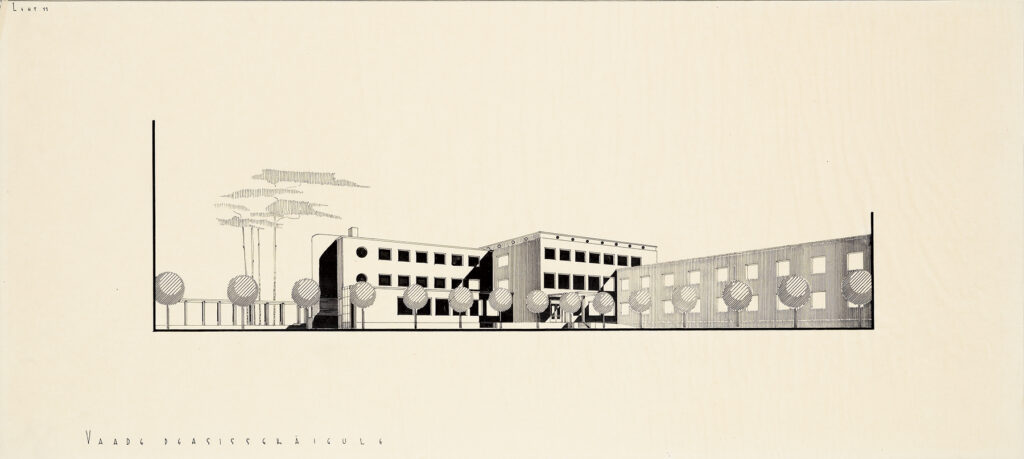August Volberg, Heili Volberg, 1958. EAM 31.1.37
Writers’ House
The Writers’ House in Tallinn old town was opened in the spring of 1963. The project of the four-storey building was designed by the architects August and Heili Volberg at the national design institute “Estonprojekt” in 1958. The seemingly laconic Writers’ House is characterized by the rationality typical of modernism. The regularly spaced windows indicate the different functions of the building – spaces for public use are located behind the large windows, private living spaces are hidden behind the smaller three-part windows. The building is connected to the historical architectural environment by a high pitched roof that fits the rooftop landscape of the old town. On the ground floor next to Harju Street, there was a book store called “Lugemisvara” with large display windows. On the corner of Harju and Vana-Posti streets, the cafe “Pegasus” with a modern interior design is located on three floors. A vestibule with a wardrobe and auxiliary rooms were originally planned in the first floor. On the next two floors are the halls of the cafe, the windows of which offer a view of St. Nicholas Church, the verdant green area and the Eduard Vilde monument. The floors of the cafe are connected by a spiral staircase. The premises of the Estonian Writers’ Union and a 150-seat meeting hall with an expressive black ceiling are located in the three-storey part of the building facing Kuninga Street. There was also space for the editors of the “Looming” magazine and the Literary Fund. In addition to the public function, two to five room apartments for writers and their families were planned in the building. In the larger apartments, one room was planned as a writer’s workspace. During the later reconstruction, the fifth floor of the house, under the roof, was built. Text: Anna-Liiza Izbaš
(klick on the picture to see more illustrations)
EAM 3.4.9; EAM 3.4.12; EAM 3.4.14
Competition works of rural cultural centre
At the end of 1947, an architectural competition was organized to find the best solution for the standard project of rural area cultural centres. 40 concept designs were submitted to the competition. Despite the large number of participants, the jury was only satisfied with the projects depicting the municipality culture centres. The first and second prizes were shared equally by Henn Roopalu’s work “Agitator” and August Volberg’s and Peeter Tarvas’ work “Tuljak”. The successful facade and plan solutions of the works were highlighted. The third prize went to the project “200” by architect Ilmar Laasi. In the opinion of the jury, the concept designs of the village’s cultural centres were of a significantly weaker level, which is probably the reason why the first and third place were not awarded. The concept design “Accent” by August Volberg and Peeter Tarvas was recognized with the II prize. At that time, community and cultural centres played an important part in the country’s cultural policy, what happened in them was controlled by the ruling power and carried the Soviet ideology to a greater or lesser extent. Text: Anna-Liiza Izbaš
(klick on the picture to see more illustrations)
-

-
A perspective view of the competition entry for the skeletal TB sanatorium in Taevaskoda
August Volberg, Edgar Velbri, 1935. EAM 31.1.66
Competition entry for the tuberculosis sanatorium in Taevaskoda
Sanatoriums were part of a healthy lifestyle that was promoted in the 1930s. Untouched natural environments started to be taken under protection as well as Taevaskoda in Põlva County in 1935. The architecture competition for skeletal TB sanatorium, held soon after, aimed to find a building fitting the environment to serve as a health institution. The first prize was given to a pair of renowned architects. Prominent shadows and a strong ink line in the drawing indicate that they were influenced by modern industry and technology. The building was designed for 90 patients and also housed the open-air school for children with pulmonary disease. The drawing was donated to the museum as a part of the archive of August Volberg by Heili Volberg in 2001. Text: Sandra Mälk










